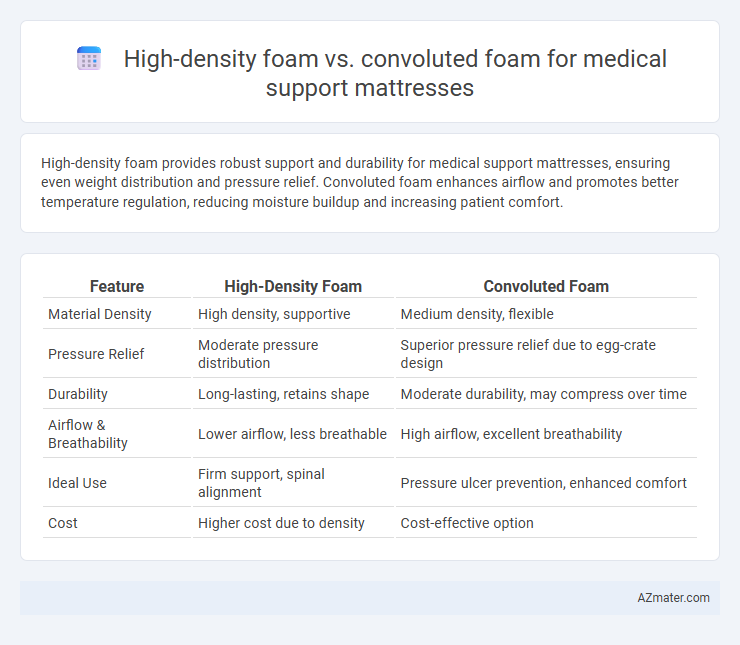High-density foam provides robust support and durability for medical support mattresses, ensuring even weight distribution and pressure relief. Convoluted foam enhances airflow and promotes better temperature regulation, reducing moisture buildup and increasing patient comfort.
Table of Comparison
| Feature | High-Density Foam | Convoluted Foam |
|---|---|---|
| Material Density | High density, supportive | Medium density, flexible |
| Pressure Relief | Moderate pressure distribution | Superior pressure relief due to egg-crate design |
| Durability | Long-lasting, retains shape | Moderate durability, may compress over time |
| Airflow & Breathability | Lower airflow, less breathable | High airflow, excellent breathability |
| Ideal Use | Firm support, spinal alignment | Pressure ulcer prevention, enhanced comfort |
| Cost | Higher cost due to density | Cost-effective option |
Introduction to Medical Support Mattresses
Medical support mattresses use high-density foam for firm, consistent support and durability, essential for pressure relief in patients with limited mobility. Convoluted foam offers enhanced airflow and targeted pressure distribution through its egg-crate design, promoting comfort and reducing the risk of bedsores. Selecting between high-density and convoluted foam depends on patient needs for spinal alignment, ventilation, and pressure management in clinical settings.
What is High-Density Foam?
High-density foam in medical support mattresses is a durable material characterized by its dense cellular structure, providing superior support and pressure distribution essential for patient comfort and injury prevention. This foam type typically ranges from 1.8 to 2.5 pounds per cubic foot in density, ensuring resilience and long-term performance in medical environments. Its firm yet adaptive qualities make it ideal for maintaining proper spinal alignment and reducing the risk of pressure ulcers in clinical settings.
What is Convoluted Foam?
Convoluted foam, also known as egg crate foam, features a unique egg crate-like surface that enhances airflow and pressure distribution, making it ideal for medical support mattresses. This foam type helps reduce pressure points and promotes better circulation, essential for patients with limited mobility or pressure ulcer risks. Compared to high-density foam, convoluted foam offers superior breathability and targeted comfort through its distinct peaks and valleys design.
Key Features of High-Density Foam Mattresses
High-density foam mattresses provide superior durability and consistent support by maintaining their shape and firmness over time, essential for medical support applications. Their closed-cell structure resists moisture and bacterial growth, enhancing hygiene and patient safety. The foam's high resilience offers excellent pressure relief, reducing the risk of pressure ulcers in long-term bedridden patients.
Key Features of Convoluted Foam Mattresses
Convoluted foam mattresses feature an egg-crate design that enhances airflow, promoting breathability and reducing heat retention, which is critical for preventing pressure ulcers in medical support applications. The foam's peaks and valleys provide targeted pressure relief by evenly distributing body weight, improving patient comfort and circulation. This design also offers increased flexibility and adaptability to body contours compared to high-density foam, making it effective for long-term use in medical environments.
Pressure Relief and Body Support Comparison
High-density foam provides consistent, firm support that evenly distributes body weight, reducing pressure points for improved spinal alignment in medical support mattresses. Convoluted foam, with its egg-crate design, enhances airflow and offers targeted pressure relief by contouring to body curves but may compress more quickly under sustained load. For long-term use, high-density foam excels in maintaining structural integrity and support, while convoluted foam optimizes surface comfort and breathability in pressure redistribution.
Durability and Longevity: High-Density vs Convoluted Foam
High-density foam offers superior durability and longevity for medical support mattresses due to its tightly packed cellular structure that resists sagging and maintains firmness over time. Convoluted foam, while providing enhanced ventilation and pressure relief through its egg-crate design, tends to compress and wear faster under continuous medical use. Choosing high-density foam ensures extended mattress lifespan and consistent support, critical for patients requiring long-term care.
Patient Comfort and Skin Protection
High-density foam provides firm support and durability, ensuring consistent pressure distribution to minimize the risk of pressure ulcers for patients requiring long-term medical support. Convoluted foam, with its egg-crate surface design, enhances airflow and reduces heat buildup, promoting skin breathability and improving patient comfort during extended use. Combining high-density foam's structural support with convoluted foam's ventilation benefits optimizes both patient comfort and effective skin protection in medical support mattresses.
Cost Considerations and Value for Healthcare
High-density foam typically offers greater durability and consistent support for medical mattresses but comes at a higher initial cost compared to convoluted foam. Convoluted foam provides effective pressure redistribution and improved air circulation at a lower price point, making it a cost-efficient choice for budget-conscious healthcare facilities. Evaluating the balance between upfront costs and long-term value is crucial for hospitals aiming to maximize patient comfort and mattress longevity.
Choosing the Right Foam for Medical Support Needs
High-density foam offers superior durability and firm support, making it ideal for patients requiring consistent pressure relief and spinal alignment in medical support mattresses. Convoluted foam, with its egg-crate texture, enhances airflow and provides gentle cushioning, reducing the risk of moisture buildup and skin irritation for users prone to pressure ulcers. Selecting the right foam depends on patient needs such as weight, mobility, and specific medical conditions, where high-density foam benefits heavier or less mobile individuals, while convoluted foam suits those needing enhanced breathability and moderate support.

Infographic: High-density foam vs Convoluted foam for Medical support mattress
 azmater.com
azmater.com